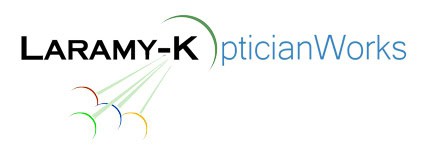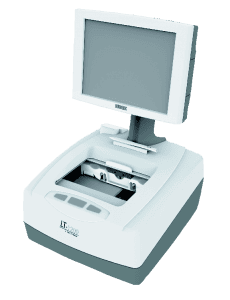Back to: 7: Finishing: The Optician’s Edge
Tracers
Tracers are how you will capture the frame shape or lens shape. Tracers usually work on a stylus but now you also have imaging and optical tracers too. You use the tracer to capture the frame shape by tracing the inside groove of the eyewire on a complete frame. You use the tracer to capture the lens shape when working with groove mounts or full rimless eyewear. Some edgers will use the frame demo-lenses as patterns. It is still possible, but rare to make a pattern as well. (watch the many videos in this course)
Remote Frame and Lens Tracing:
Although quite rare today, another option available under the finishing umbrella is remote frame and lens tracing. Remote tracers are purchased outright, leased, or provided by a lab in exchange for the work they provide. A remote tracer is just that, you have only the tracer portion of an edger system in your store and you trace frames and/or lenses (for semi-rimless and full rimless) and send the data to a lab online. The lab surfaces the job and then uses the trace data to finish the lenses. You receive a set of lenses ready to be put in a frame.
Remote tracing allows your customer to continue wearing his or her frame until the new lenses arrive. Once they do, all you have to do is swap them out.
Some edgers can work as remote tracers.
Q: Why the heck would I have an edger but then use it to send a trace to a lab?
A: Frame traces can help the lab produce a better un-cut lens. When dealing with high powers, having the frame data helps the lab custom design the thinnest lens possible. You may have an edger that doesn’t drill so you can send shape data to the lab by tracing it. You may have a job that you simply want the lab to finish for you. Heck, maybe your star optician is on vacation or maternity leave.
Just be sure that you know how to calibrate the tracing unit to assure proper fit. The lenses you get will only be as good as the trace you send out.
Santinelli’s LT 1200 Tracer
Frame Tracing Memory
Any good edger will have the ability to trace a frame or lens and store the trace data. This means that a customer does not have to do without their glasses while their new lenses are being made.
It also allows repeat cuts on batches of similar frames.
You may have a safety eyewear account and need to run a certain frame 10, 20 or even 100 times a year.
- Write up complete new order
- Take the order form and the customer’s glasses and go to the edger
- Remove lenses from frame [mark horizontal first for semi-rimless or round]
- Enter all the job parameters and trace the frame or lens
- Save job to edger memory
- Reassemble glasses
- Return glasses to customer
When the uncut lenses arrive from your wholesale lab, simply pull up the job from memory and cut the lenses.
Call the customer and when they stop by, all it takes is just a few minutes to swap out the old lenses for the new ones.
Note: I am not a fan of memory tracing! If you can avoid it, don’t do it. Every time you take a pair of glasses apart you can run into trouble. Why do it more than you have to? This is especially true when dealing with older plastic frames which are bound to break with repeated lens insertion and removal.
Unless you work alone, you may also find that your co-workers may not complete the data entry, or they may use the memory function as a way to pass off work.
If you do a memory trace be sure you note the Memory #, enter ALL your job parameters and that you traced the lens shape on the order form!
Don’t say I didn’t warn you!
Changing Tracer Data
Even some of the more basic edgers allow you to “tweak” the B measurement of a trace. This is hardly high-end artistry but it does set you apart from others. Using the edger, you can add or subtract to the overall depth of a semi-rimless, or full-rimless frame. In a semi-rimless you just need to add or subtract some mounting cord length.
Let’s say Mr. Goldstein finds a semi-rimless frame and says, “That shape is almost perfect but, if it were just a tiny little bit more of a rectangle I’d be happier. I’m getting just a little cheek touch that I know will get annoying.”
You talk with Mr. Goldstein and agree that about 1.5mm would be enough. You take the frame into lab, trace the lens shape, tweak the B down 1.5mm and run a test lens in a basic plastic demo, reassemble, and let him OK the work. He says, “Yes!” You say, “Great!” You just set yourself apart from the online retailer.

